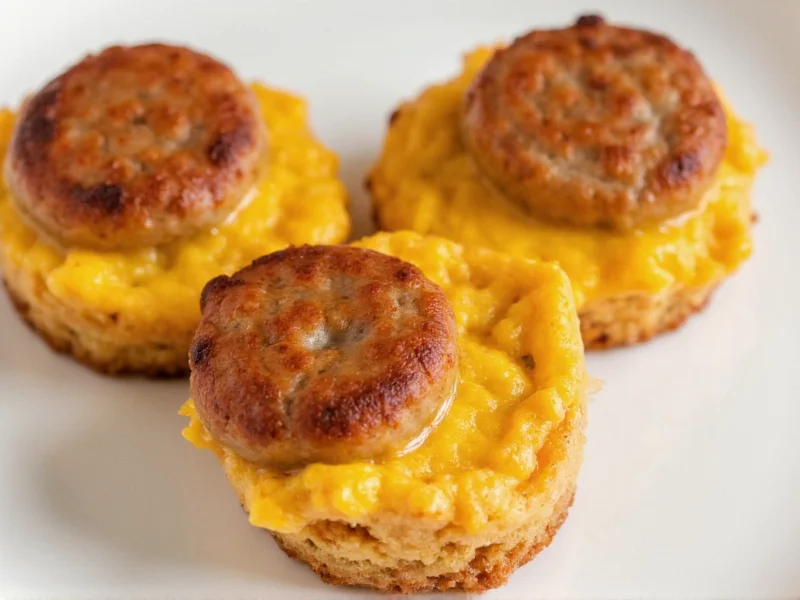Sausage egg bites have surged in popularity as a convenient, protein-rich breakfast solution that perfectly balances taste and nutrition. Unlike the often expensive café versions, making these at home allows for complete control over ingredients while significantly reducing costs. The ideal homemade sausage egg bite features a delicate custard-like texture with evenly distributed savory sausage pieces and melted cheese throughout.
What Makes Sausage Egg Bites Special
These breakfast cups stand out from ordinary egg muffins due to their signature creamy texture, achieved through specific preparation techniques. The magic happens when eggs are gently baked with a small amount of liquid (like milk or cream), creating a restaurant-quality result that's neither rubbery nor dry. Traditional sausage egg bites incorporate high-quality breakfast sausage—either mild or spicy—along with complementary cheeses like sharp cheddar or Monterey Jack.
Essential Ingredients for Perfect Results
The foundation of exceptional homemade sausage egg bites rests on these key components:
| Ingredient | Recommended Amount | Professional Tip |
|---|---|---|
| Eggs | 6 large | Use room temperature eggs for smoother texture |
| Milk or cream | ¼ cup | Whole milk creates creamier results than alternatives |
| Cooked sausage | ½ cup crumbled | Pat cooked sausage dry to prevent watery bites |
| Shredded cheese | ⅓ cup | Pre-shredded cheese contains anti-caking agents—use block cheese |
| Salt and pepper | To taste | Add salt after cooking sausage to control sodium levels |
Step-by-Step Preparation Guide
Follow these professional techniques to achieve café-quality sausage egg bites at home:
- Prepare your sausage: Cook ½ pound of breakfast sausage in a skillet over medium heat until fully browned. Drain thoroughly and press with paper towels to remove excess grease.
- Whisk egg mixture: Beat 6 large eggs with ¼ cup milk, ¼ teaspoon salt, and ⅛ teaspoon black pepper until just combined (avoid overbeating).
- Prepare molds: Generously grease a standard muffin tin or silicone molds—this prevents sticking and ensures clean removal.
- Layer ingredients: Divide cooked sausage evenly among cups, then gently pour egg mixture over the sausage, filling cups about ¾ full.
- Bake properly: Place muffin tin in a larger roasting pan and fill with hot water to create a water bath (bain-marie). Bake at 325°F for 20-25 minutes until set but still slightly jiggly in center.
- Cool completely: Allow egg bites to cool in the pan for 10 minutes before transferring to a wire rack—this prevents overcooking.
Avoiding Common Preparation Mistakes
Many home cooks encounter issues with their sausage egg bites due to these preventable errors:
- Overbaking: Removing egg bites from the oven when they're still slightly soft in the center prevents rubbery texture as they continue cooking off-heat.
- Insufficient greasing: Even silicone molds benefit from light greasing—use avocado oil spray for best release.
- Using pre-shredded cheese: The starch coating on pre-shredded cheese creates a grainy texture—always shred your own cheese.
- Skipping the water bath: The gentle, moist heat from a water bath creates the signature creamy texture of professional egg bites.
- Adding vegetables with high water content: If including vegetables like mushrooms or spinach, sauté and thoroughly drain them first.
Dietary Variations for Special Needs
Homemade sausage egg bites easily adapt to various dietary requirements:
Keto-Friendly Sausage Egg Bites
Replace milk with heavy cream and use sugar-free sausage. Add 1 tablespoon nutritional yeast per cup of egg mixture for cheesy flavor without carbs. Each bite contains approximately 90 calories, 7g fat, 1g carbohydrate, and 6g protein.
Gluten-Free Preparation
Naturally gluten-free, but verify sausage ingredients as some brands contain breadcrumbs. Look for "no fillers" on packaging or make your own sausage blend using ground pork and spices.
Dairy-Free Alternative
Substitute cheese with 2 tablespoons nutritional yeast per cup of egg mixture for umami flavor. Use coconut milk instead of dairy milk for creaminess without dairy.
Storage and Reheating Instructions
Proper storage maintains texture and flavor of your sausage egg bites:
- Refrigeration: Store in airtight container for up to 4 days. Place parchment paper between layers to prevent sticking.
- Freezing: Freeze individually on baking sheet, then transfer to freezer bag. Keeps well for 2-3 months.
- Reheating: Microwave single bite for 45-60 seconds or warm in toaster oven at 350°F for 8-10 minutes for best texture.
- Meal prep tip: Freeze in portioned containers with cooking instructions written on labels for quick breakfasts.
Nutritional Benefits of Homemade Sausage Egg Bites
Compared to store-bought versions, homemade sausage egg bites offer significant nutritional advantages:
- Higher protein content (approximately 10g per bite) with better quality protein sources
- Reduced sodium levels (control your own salt content)
- No preservatives or artificial ingredients
- Customizable fat content based on sausage selection
- Ability to incorporate vegetables for added nutrients
A typical homemade sausage egg bite contains about 120-150 calories, making it an ideal portion-controlled breakfast option that keeps you satisfied until lunch. The combination of protein and healthy fats provides sustained energy without blood sugar spikes common with carbohydrate-heavy breakfasts.
Perfecting Your Technique: Advanced Tips
Elevate your sausage egg bites with these professional techniques:
- Temperature control: Bring all ingredients to room temperature before mixing for more uniform texture.
- Straining eggs: Pour beaten eggs through a fine-mesh sieve to remove chalazae (the stringy bits) for smoother texture.
- Flavor layering: Add ¼ teaspoon onion powder and ⅛ teaspoon garlic powder to the egg mixture for depth of flavor.
- Texture variation: For restaurant-style texture, replace 2 whole eggs with 4 egg whites in your recipe.
- Steam prevention: Cover muffin tin loosely with foil during the last 10 minutes of baking to prevent surface bubbles.











 浙公网安备
33010002000092号
浙公网安备
33010002000092号 浙B2-20120091-4
浙B2-20120091-4